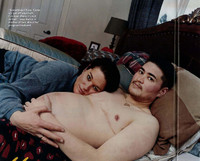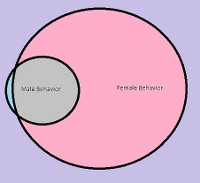Keywords: why it was, before you tear down a wall
***

MTF vs FTM transsexuals
I was reflecting that there were a lot more male-to-female transsexuals (MTF) than female-to-male (FTM) ones. In other words, there are many more biological men want to be[come] women than biological women who want to be[come] men.


More of one than the other
This would be the starting point of a theory as to why this is so, but before coming to that, I have to prove what I have just asserted.
While statistics are hard to come by, estimates report, as a baseline statistic, something like 1 in 30,000 for MTFs and 1 in 100,000 for the reverse (FTMs). Other estimates are consistent in that there are many more MTFs than FTMs*.
Why do more men want to become women than vice-versa?

One reason I considered for this discrepancy was that one wants to benefit from the power dynamics of being an object of desire. It might also be argued that it is more fulfilling to be the object of desire than the subject who desires. Yet, it is not easy or trivial to change gender, so while nice this is probably not a major reason (besides which, transwomen are generally considered less attractive than biological women).
I would suggest a more important - THE most important - reason. As feminism and sociology teach us, there is a difference between sex and gender. Sex is the purely biological aspect whereas gender is learned and performed&.

While I don't take it quite as far as they do, the essential insight here is that one can perform aspects (or even the entirety) of the gender role of the other gender, without having the sexual organs of the other gender.
In developed countries certainly (and perhaps even in developing countries), it is a lot more acceptable for women to take on masculine traits and behaviors than for men to affect feminine ones. This is not to say that it is totally penalty-free for women to take on all masculine traits and behaviors, but the range of circumscribed behaviors is much smaller, and the sanctions for transgressing the norms much lighter. We can see this from there being a lot more Drag Queens than Drag Kings (there are almost none of the latter, in fact).
For those who love venn diagrams, here is one:

Obviously a bigger sphere of possibilities is better than a smaller one.
The Female vs the Unisex
This builds upon a decade-old insight of mine: there are two types of fashion - female and unisex. The same applies to hair and footwear as well. Yet, the scope of possibilities goes way beyond that.
I highlight here a most interesting study (Another ceiling? Can males compete for traditionally female jobs? / Leanne E. Atwater, David D. Van Fleet), which found that women have been getting more access to traditionally male jobs:

Pazy (1992) actually found profemale bias among subjects asked to rate applicants for promotion to a management position in a gender-neutral job. Powell and Butterfield (1994) found no gender bias in selection decisions for senior-level executive positions in federal civil service (traditionally thought to be the domain of males). Haemmerlie and Montgomery (1991) disconfirmed Goldberg's (1968) classic finding that both males and females placed a higher value on work done by a male. In the Haemmerlie and Montgomery study, the opposite was found. In engineering and law (occupations traditionally dominated by males), work was evaluated more positively when done by females than by males. Additionally, from 1981 to 1991 the percentage of women managers in the workplace increased 14 percent (from 27 to 41 percent) (Dalton & Kesner, 1993). It appears that females are now being accepted as viable management candidates in many arenas and may even be the preferred candidates in some jobs [: those involving women]
Most telling, though is that:
There is some evidence that females are more likely to be entering and advancing in traditionally male occupations than are males in traditionally female fields... [in an experiment,] profemale bias existed for selection decisions made in traditionally female jobs... the findings that less-qualified females will be selected over more-qualified males in traditionally female jobs are somewhat disconcerting given the attention paid recently to diversity and equal employment opportunity. It is possible that previous attention has been so heavily devoted to discrimination against women and minorities that the issue of equal opportunities has not yet generalized to include males

In other words - women can do men's jobs, but men cannot do women's jobs.
(Incidentally, page 8 is very telling in its reporting of the finding that women are more discriminated against in hiring decisions if less job-relevant information is given; the more the hirer knows about the applicant, the less gender is a consideration. This is entirely what would be expected if gender were used as a proxy variable for ability, rather than a blunt determiner)
Also, as more than one female I know has mused, it is better to marry a rich guy as he will be able to support you so you can go and do whatever you want, unconstrained by the need to bring home the bacon. Of course, women can still choose to be Career Women if they wish, but essentially this choice is not open to males.
The female is coded as frivolous, impractical and useless.
Meanwhile, the male is coded as serious, practical and utilitarian - and thus suitable for all (even such frivolities as tie clips and cufflinks ultimately serve some practical purpose).
A Corollary Prediction: Panel Analysis
If my theory is correct, you would expect to see more a equal ratio of male:female to female:male transsexuals in a more conservative country, and the former will increase as it becomes more liberal and women get the right to adopt traditionally male behaviors. Unfortunately data availability is an issue for the inter-spatial comparison, but inter-temporal might work (this is where hiring an RA would come in handy).
A Corollary Phenomenon: Why Women are growing more Unhappy
My theory also explains the finding that feminism and women's liberation has resulted in women becoming more miserable over the years ("The Paradox of Declining Female Happiness").
While the feminists trot out their favourite bugbears, this finding is easily explained - greater unhappiness is the corollary of having a greater sphere of possibilities.
This is the same reason why someone who takes 9 subjects for his O levels (for those who still do O levels, anyway) have more flexibility in aiming for a good
L1R5, but will probably also feel pressure to score well in all his subjects in order to get a good MSG (Mean Subject Grade). Sitting for fewer subjects gives one less flexibility, but there is also more time and energy for each subject in particular.
A Fashionable Feminist Fudge: Women are Inferior
When I expounding this theory, one objection raised quoted
"Girls can wear jeans
And cut their hair short
Wear shirts and boots
'Cause it's OK to be a boy
But for a boy to look like a girl is degrading
'Cause you think that being a girl is degrading"

That's certainly one interpretation which would fly in a GP essay or feminist text. Yet, here we are interested in deeper analysis, so let's take this one step further.
If this were the case - that being a girl was degrading - then females would be despised for being and acting female: by males, other females and themselves. Yet, we do not see this but instead a celebration of female femininity: by males, other females and themselves.
Indeed, while females who adopt male roles or attributes are certainly not unpopular or deficient, the most feted females are not those who are the most successful in taking on male roles or attributes - bref, those who epitomise masculinity. If this were the case, the most popular female role models would be Margaret Thatcher and Ho Ching. There isn't a unidimensional value scale here, with extreme masculinity at the top and extreme femininity at the bottom - regardless of the sex of the individual.
The data bears this out, with one survey showing that most women between 21-25 want to be "a WAG (footballer's wife or girlfriend) rather than a powerbroking executive" (this was a survey by MORE magazine, but given the neat sample size of 2,000 this was almost certainly not a poll of their readers. In any case their tagline is "For Women of Style and Substance").
That British women admired Margaret Thatcher and the Queen is not evidence against my theory either, as that survey asked which women were *influential*, not which women they'd want to be; indeed, 31% of respondents said Thatcher was the most influential, but only 2% wanted to be her - most wanted to be the undeniably more aesthetically pleasing J K Rowling. Note too that the next few were Florence Nightingale, Mother Teresa, The Queen, Oprah Winfrey, Michelle Obama - hardly evidence that shattering gender roles makes you admired by other women, since their claims to fame are, respectively: treating the wounded and the dying with tender, loving care; treating the poor with tender, loving care; being born into the right family and owning the most and largest jewels in the country; being Queen of the gossip circuit, hugging everyone who comes onto your show and losing 67 pounds in 4 months on a liquid diet; having nice arms, great dress sense and marrying the right man.

Despite, not Because of
[Ed: Since writing this post, I have become acquainted with the Bern Sex-Role Inventory (BSRI, 1974) which classifies psychological traits as Masculine, Feminine and Neutral.
Contrary to the predictions of the Fashionable Feminist Fudge, both men and women judged a feminine psychological trait to be more socially desirable in a woman than a masculine one. These findings held in Holt and Ellis's 1998 assessment of its validity.
In other words, people like men to be masculine and women to be feminine - they do not like their women to be masculine.]
The best way to falsify this Fashionable Feminist Fudge would be to use the ceteris paribus (all things being equal) assumption and ask women if they would rather be in a state of X, or a state of X+Y, where Y is a feminine trait. However, I am positive that no such research has been carried out (and I am equally positive that the vast majority of women would rather have a waist:hip ratio of 0.7 to 0.95).
In the absence of such a study, the booming market for female magazines, cosmetics, clothes and general beautification is also hardly testament to women rushing to abandon their femininity and take up masculine traits.
The claim that the female is coded is inferior also does not seem to gel well with the APA's reporting that "as many as 2-3% of biological males engage in cross-dressing, at least occasionally" (or at least, my proposal gels better).
A counter-claim would be that to be born female is to be immutably inferior, and that women cannot rise above their inferiority no matter what they do, so there is no point. Yet, this is indistinguishable from my theory in results. One could thus take one's cue from Occam's Razor and not multiply entities unnecessarily, as this claim does not seem to add anything to our understanding of the situation.
An objection: Transsexuals seeking treatment vs All Transsexuals
Going back to the original phenomenon that sparked my meditation, one objection is that this is just the number of people who seek treatment (or who are interested in doing so). Those who do not are thus uncounted. Since it is a lot easier for a man to get a sex change than a woman (this was once put poetically to me as it being easier to cut off something than construct something), there will thus appear to be a lot more MTFs than FTMs.
Yet, at least some of the estimates include those who undergo hormonal treatment - even if they do not undergo sex reassignment surgery, and the APA's statistics use a broad definition which includes those who don't seek medical intervention. Transsexualism is not defined by having undergone, being about to undergo or even wanting to undergo surgery (or even treatment), but merely the desire to be and live as a member of the opposite sex. Indeed, many FTMs do not bother having the full shebang to construct a penis, because it will look weird and be non-functional. Yet they may take hormones and so be [more or less] undistinguishable from a real man (unless you pull down their pants or kick them in their [non-existent] balls).
I cite someone else who agrees with me
However, even if one argues that there are as many MTFs as FTMs, this does not invalidate my theory. To end, let me invoke authority and quote Matt Kailey in Just add hormones: an insider's guide to the transsexual experience:
It’s far easier for a female to live in society as a male without any hormones or surgery than vice versa. In the past, and probably still, many transgendered females have opted to simply present themselves as men and live their lives as men rather than seek help through therapeutic and medical intervention. Therefore, they haven’t come to the attention of statistics gatherers.
It’s also far easier for a transgendered female to live as a masculine female, dressing in men’s clothing, wearing a male hair style, and generally presenting in a masculine way than it is for a male to wear a dress, high heels, and a wig. Masculine females are far more accepted in our culture than feminine males. Therefore, some transgendered females have chosen to remain in a female role with the accoutrements of masculinity rather than undergo hormone treatments and surgeries, which always have risk.

Addendum: As for why the masculine is unisex - it wasn't always this way. For example the sole crime that Joan of Arc of charged with was of wearing men's clothing, which got her burnt at the stake.
Basically thanks of the efforts of feminists, it became acceptable for women to imitate men - but the reverse has yet to happen.
***
* - That said, a novel study took out Google Ads to estimate the gender ratio of MTFs:FTMs in the English-speaking online world, and estimated a ratio of 1.29 for MTFs:FTMs. The slides explain that the gap is due to a 12 year time lag, but as I was not privy to the actual presentation I do not know how convincing this argument is. Still, the main thrust of this post remains unaffected. (Return to body of blog post)
& - Incidentally the fact that transsexuals persist in the face of strong social barriers is a telling blow against the claim that gender is always and everywhere a phenomenon due to socialization, but hopefully that popular myth is dead in most - even if not all - sectors. (Return to body of blog post)


